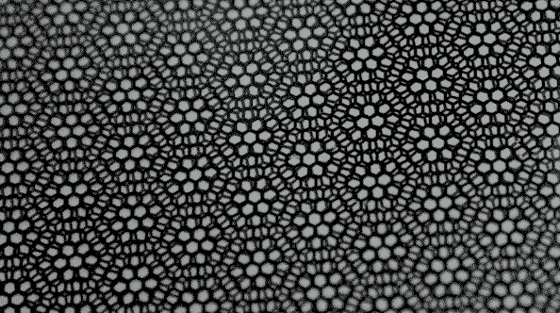Succeeded in creating both superconductivity and insulation by shifting the angle between two graphene layers

It consists of carbon atoms and is a single phase "Graphene"Is expected to be applied as a material that can be given superconductivity, and is expected to be applied in various fields. Researchers at MIT and Harvard University discovered that they can be turned into superconductors and insulators by overlapping graphene sheets with a thickness of one carbon and shifting the angle slightly.
Unconventional superconductivity in magic-angle graphene superlattices | Nature
https://www.nature.com/articles/nature26160
Insulator or superconductor? Physicists find graphene is both | MIT News
http://news.mit.edu/2018/graphene-insulator-superconductor-0305
Graphene discovered in 2004 is a carbon material spreading in the form of a honeycomb in the form of carbon atoms spreading in a plane, surprisingly light, soft, and high thermal conductivity while having strength several hundred times higher than iron It has the property that conductivity is higher than copper. It is also known that superconductors can be made by contacting other superconducting metals and graphene, and it is one of the promising materials for next-generation semiconductor materials.
The research group of Associate Professor Pablo Jalilo Hellerero of MIT and Professor Esimios Caziras of Harvard University superimposed the graphene sheets together to give a structure called "superlattice", so that "superconductivity" We have succeeded in having absolutely the opposite electrical property "insulation" from the scientific journal Nature.
Researchers call a specific angle at which electrical characteristics can be changed as "Magic Angle" because completely different electrical characteristics can be obtained by slightly changing the angle of the seat. By clicking on the image below you can check animation how the angle of the sheet is shifted.

The research group created a superlattice of two graphene by peeling off a single graphene from graphite and scooping up the graphene layer with a slide covered with sticky polymer and boron nitride insulating material . Then, while graphene sheets were rotated in the range of 0 degree to 3 degrees, conductivity was examined by the attached electrodes. According to Associate Professor Jalilo Hellerelo, the angle control is very severe, and the special electrical characteristics will disappear by only 0.2 degree difference.
First, researchers found that the graphene superlattice was "Mott insulator"We have found that it adopts a band structure of electrons similar to. After that, a small amount of oxygen was supplied to the Mott conductorDopeWe examined whether superconductivity can be given by adding electrons to the graphene superlattice, just as it turns into superconductors. Researchers added a small amount of electrons while adding a small gate voltage to the magic angle graphene superlattice. As a result, electrons got together with other electrons in graphene, so that electrons flowed to places where it could not flow until then. It seems that when you continue to measure electric resistance, you know that it has superconductivity through which current flows without consuming energy.
According to researchers, it is extremely important to be able to change various electrical properties from insulator to superconductor by a single material called graphene. Analysis of graphene superlattice is expected to be useful for elucidating the mechanism of high temperature superconductors.
Related Posts:
in Science, Posted by darkhorse_log







